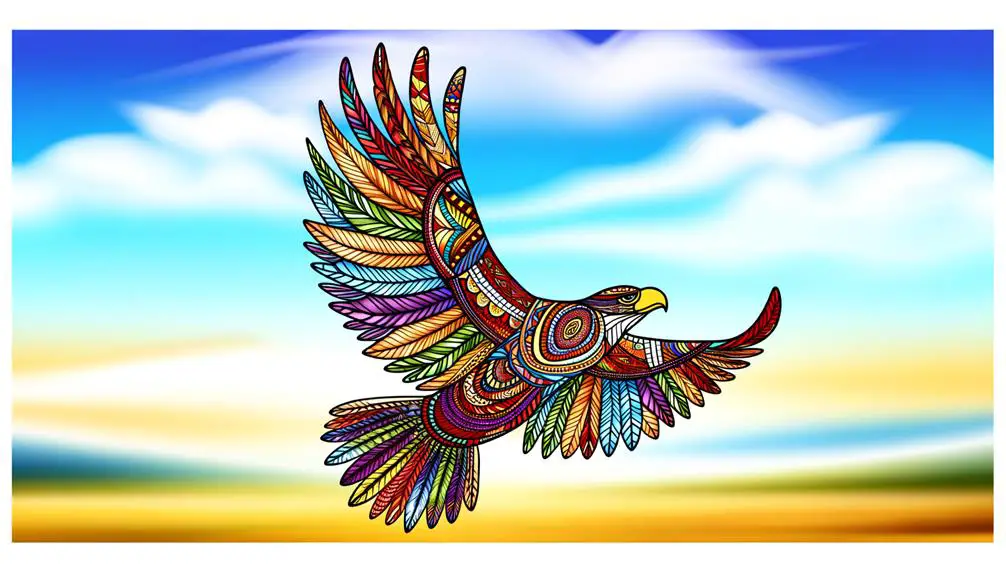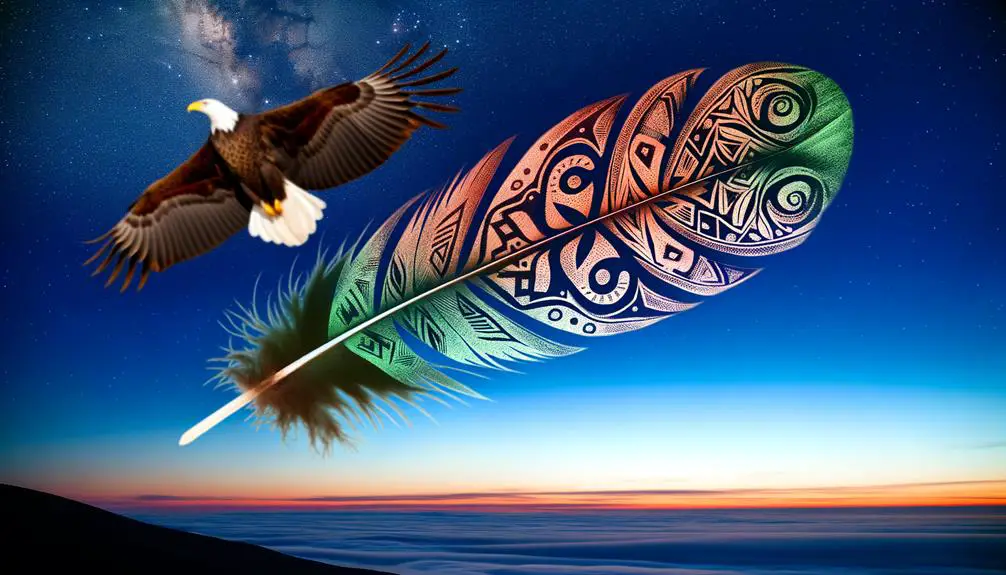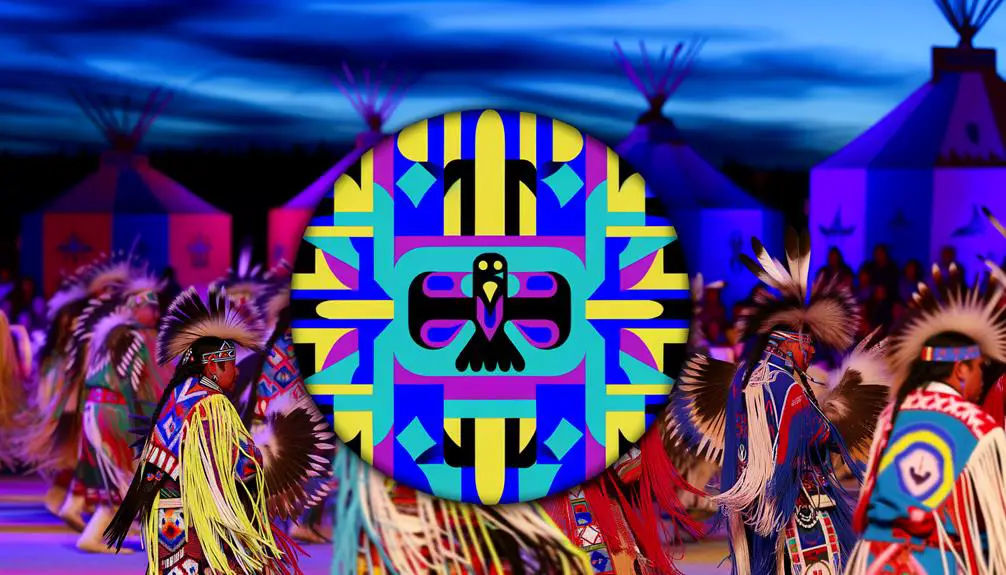Eagle Symbol Significance in Native American Culture
The eagle holds profound spiritual significance in Native American cultures, symbolizing vision, strength, and a sacred connection to the divine. Often regarded as a bridge between the earthly and spiritual domain, the eagle embodies keen perception, wisdom, and vigilance.
Its feathers are integral in ceremonies, bestowing protection and blessings. Different tribes, including the Lakota Sioux and Cherokee, assign unique meanings to the eagle, but consistent themes of bravery and freedom remain.
This emblem of cultural pride and spiritual reverence appears extensively in art and ceremonies. Explore further to understand the full depth of the eagle's revered status across tribes.

Key Takeaways
- The eagle symbolizes vision, strength, and a sacred connection in Native American cultures.
- It serves as a divine messenger between the earthly and spiritual realms.
- Eagle feathers are used in ceremonies for protection and blessings.
- The eagle represents freedom, unrestrained spirit, and the pursuit of dreams.
- It embodies resilience, cultural pride, and spiritual reverence in Native American art and rituals.
Eagle as a Spiritual Guide

The eagle, revered across various Native American cultures, serves as a powerful spiritual guide symbolizing vision, strength, and a deep connection to the divine.
Historically, the eagle's ability to soar high above the earth has been interpreted as a bridge between the physical and spiritual domain. Its keen eyesight is emblematic of heightened perception and insight, qualities essential for leadership and wisdom.
The eagle's strength and majestic presence further lend it a role as a guardian and protector. Culturally, eagles are often featured in ceremonies and rituals, reinforcing their significance as messengers of the gods.
This profound respect is embodied in the use of eagle feathers in sacred objects, marking the eagle as a pivotal figure in spiritual and cultural practices.
Tribal Interpretations of the Eagle
Throughout Native American history, the eagle has held profound spiritual significance across various tribes. It is often regarded as a messenger between the earthly and spiritual domains. In many cultures, the eagle is seen as a protector, embodying strength and bravery.
Additionally, its soaring flight symbolizes freedom and a higher viewpoint, which are deeply revered in tribal traditions.
Spiritual Significance Across Tribes
Eagles hold deep spiritual significance among many Native American tribes, symbolizing strength, vision, and a sacred connection to the divine. Historically, eagles were revered in ceremonies and depicted in art, embodying a bridge between the earthly and spiritual domains. The symbolic meaning of eagles varies across tribes but retains core elements of power and reverence.
- Lakota Sioux: The eagle represents a messenger between humans and the Creator, embodying wisdom.
- Cherokee: Eagles are seen as protectors and are integral to sacred dances and rituals.
- Hopi: Eagles are associated with fertility and rain, essential for agricultural success.
- Navajo: Eagles are seen as carriers of prayers to the heavens, symbolizing spiritual communication.
Each tribe uniquely integrates the eagle into its cultural practices, underscoring its universal significance.
Eagle as Protector
In many Native American cultures, the eagle serves as a powerful symbol of protection, revered not only for its physical prowess but also for its spiritual guardianship.
Historically, tribes such as the Lakota, Cherokee, and Hopi regarded the eagle as a divine messenger, believed to carry prayers to the heavens.
Symbolically, the eagle's sharp eyesight and majestic flight embody vigilance and a higher perspective, qualities essential for safeguarding communities.
Culturally, eagle feathers are often used in ceremonies to invoke protection and blessings, reflecting the bird's esteemed role as a guardian.
The eagle's presence, whether in art, rituals, or folklore, underscores its enduring significance as a protector, bridging the earthly and spiritual domains.
Symbol of Freedom
Beyond its role as a protector, the eagle also epitomizes freedom across various Native American tribes, symbolizing the unrestrained spirit and the limitless skies. Historically, the eagle's ability to soar high above the earth connected it with the divine, representing a bridge between the physical and spiritual worlds. Symbolically, its flight embodies liberation and the pursuit of dreams. Culturally, the eagle is revered in ceremonies and artwork, reflecting its esteemed status.
Unrestricted Flight: Represents the soul's journey toward enlightenment.
Sky's Majesty: Signifies the vast possibilities of life.
Spiritual Messenger: Acts as a conduit between humans and the Creator.
Ceremonial Importance: Central to rituals, symbolizing hope and renewal.
Understanding these interpretations deepens appreciation for the eagle's multifaceted significance.
Symbolism in Eagle Feathers

Delving into the cultural significance of eagle feathers reveals their profound symbolic meanings, deeply rooted in Native American traditions and spiritual practices. Historically, eagle feathers have been revered as sacred objects, symbolizing honor, bravery, and spiritual wisdom.
Each feather is regarded as a gift from the Creator, carrying prayers and conveying a deep connection to the divine. The eagle, soaring high and touching the heavens, embodies a bridge between the earthly and spiritual domains. Consequently, the feathers are often bestowed during significant rites of passage or as marks of exceptional accomplishments.
Their cultural significance extends to fostering a sense of identity, unity, and continuity among Native American communities. Therefore, eagle feathers are not mere adornments but profound symbols of spiritual and communal heritage.
Eagle in Ceremonial Practices
In Native American ceremonial practices, the eagle holds profound symbolic meaning, often signified through the use of eagle feathers, which are considered sacred and imbued with spiritual power.
Eagle dances, performed in various tribes, embody the eagle's grace and strength, serving as a medium to connect with the divine.
The eagle is also revered as a messenger, believed to carry prayers to the Creator, further cementing its role in ritualistic and spiritual contexts.
Eagle Feather Significance
The eagle feather holds profound ceremonial significance in Native American culture, symbolizing honor, strength, and a deep spiritual connection to the Creator. Historically, many tribes revered the eagle as a messenger between humans and the divine.
The symbolic importance of the eagle feather is multifaceted:
- Honor: Receiving an eagle feather is considered one of the highest marks of respect.
- Strength: The feather represents the courage and resilience of the individual.
- Spiritual Connection: It serves as a conduit for prayers and spiritual guidance.
- Cultural Identity: Feathers are often used in traditional regalia, signifying tribal heritage.
In ceremonies, eagle feathers are used to bless, heal, and connect participants with their ancestors, reinforcing their cultural and spiritual ties.
Eagle Dances Explained
Eagle dances, integral to many Native American ceremonial practices, embody a deep reverence for the eagle's symbolic role as a bridge between the physical and spiritual worlds. Historically, these dances have been performed to honor the eagle, invoking its strength and vision. Symbolically, the dance mimics the eagle's movements, representing a connection to the divine. Culturally, eagle dances serve as a means to convey prayers, seek guidance, and guarantee community well-being.
| Aspect | Historical Context | Cultural Significance |
|---|---|---|
| Purpose | Pay tribute to the eagle | Community well-being |
| Movements | Imitate eagle's flight | Convey prayers |
| Symbolism | Connection to the divine | Seek guidance |
| Participants | Tribal members | Community involvement |
| Timing | Specific ceremonial occasions | Integral to cultural rituals |
Understanding these elements deepens appreciation of eagle dances' profound role in Native American cultures.
Eagle as Messenger
How does the eagle's role as a messenger in Native American ceremonial practices encapsulate its historical, symbolic, and cultural significance?
Historically, the eagle has been venerated for its closeness to the divine, often seen as a link between the earthly and spiritual domains.
Symbolically, the eagle represents vision, strength, and freedom, qualities esteemed in Native American culture.
Culturally, the eagle's feathers and presence in rituals underscore its sacred role in conveying prayers and messages to higher powers.
—
- Historical context: Revered as an intermediary to the divine.
- Symbolic meaning: Embodies vision, strength, and freedom.
- Cultural significance: Integral to rituals and spiritual communication.
- Ceremonial role: Feathers used in sacred rites to connect with the spiritual world.
—
This multifaceted significance enriches its revered status.
The Eagle Dance

Rich in cultural significance, the Eagle Dance embodies a ceremonial tradition that honors the majestic eagle, a symbol of strength and spiritual connection in Native American heritage.
Historically performed by various tribes, including the Hopi and the Lakota, the dance serves to invoke the eagle's revered qualities, such as courage, wisdom, and a deep connection to the divine.
Symbolically, dancers often don elaborate feathered regalia, mimicking the eagle's movements to convey reverence and emulate its flight.
Culturally, the Eagle Dance is not merely a performance but a profound spiritual practice, strengthening communal bonds and fostering a collective sense of identity and continuity.
Its enduring presence underscores the eagle's crucial role in Native American spirituality and cultural expression.
Eagle in Mythology and Legends
Throughout Native American mythology and legends, the majestic bird often symbolizes a bridge between the earthly domain and the spiritual world. The eagle is revered for its unique attributes, embodying profound symbolic meanings and cultural significance. Legends often depict the eagle as:
- A messenger that carries prayers to the Creator.
- A symbol of strength, freedom, and vision.
- A harbinger of change and renewal.
- An embodiment of the sun, representing light and life.
Historically, the eagle's soaring flight and piercing eyesight are seen as qualities that connect the physical and spiritual worlds, making it a powerful totem.
The eagle's presence in various myths underscores its role as a revered figure, integral to understanding Native American cosmology and spiritual practices.
Eagle as a Protector

In Native American traditions, the eagle is revered as a guardian of the skies, embodying both spiritual strength and guidance.
Historically, its soaring flight and keen vision have symbolized an all-seeing protector watching over the land and its people.
This majestic bird's cultural significance is profound, often invoked in rituals and ceremonies to provide wisdom and safeguard communities.
Guardian of the Skies
The eagle, revered in Native American culture, stands as a powerful symbol of protection and guardianship over the skies. Historically, many tribes viewed the eagle as a celestial sentinel, watching over the land and its people from lofty heights. The symbolic meaning of the eagle encompasses various facets of protection:
- Vision and Clarity: The eagle's keen eyesight symbolizes foresight and vigilance.
- Strength and Courage: Its powerful build represents bravery and resilience.
- Freedom and Authority: Soaring high, the eagle embodies autonomy and leadership.
- Divine Connection: Often seen as a messenger between the earthly and the spiritual domains.
Culturally, the eagle's presence in rituals and ceremonies underscores its role as a guardian, ensuring harmony and balance within the community.
Spiritual Strength and Guidance
Beyond its role as a celestial sentinel, the eagle also embodies spiritual strength and guidance, revered as a protector who offers wisdom and support to those seeking direction in life. Historically, Native American tribes have viewed the eagle as a powerful intermediary between the earthly domain and the divine.
Symbolically, the eagle's keen vision and soaring flight represent the ability to see beyond the immediate, offering clarity and insight. Culturally, the eagle is often invoked in rituals and ceremonies to provide spiritual protection and to guide individuals on their life paths.
The eagle's majestic presence is a reminder of the interconnectedness of all life, urging respect for nature and a deeper understanding of one's spiritual journey.
Modern Cultural Significance
Embracing its historical context and symbolic meaning, the eagle remains a powerful emblem of freedom and spiritual insight within contemporary Native American communities. Revered for its ability to soar to great heights, the eagle is often seen as a mediator between the earthly and the divine. It embodies various facets of modern cultural significance:
- Ceremonial Use: Eagle feathers are integral in rituals and ceremonies, symbolizing honor and connection to the Creator.
- Advocacy and Identity: The eagle represents resilience and cultural pride, often used in activism and community identity.
- Educational Initiatives: Programs involving the eagle educate younger generations on heritage and environmental stewardship.
- Healing Practices: The eagle's symbolism is employed in traditional healing, reflecting its role as a spiritual guide.
This enduring presence underscores the eagle's profound cultural resonance.
Eagle Imagery in Art

Incorporating centuries of tradition and symbolism, eagle imagery in Native American art serves as a profound expression of cultural identity and spiritual reverence.
Historically, the eagle has been venerated across numerous tribes for its connection to the divine, often depicted in ceremonial regalia, totem poles, and intricate beadwork.
Symbolically, the eagle represents strength, courage, and the messenger between humans and the Creator, embodying various spiritual and moral virtues.
Culturally, the eagle's imagery is pivotal, reinforcing communal values and ancestral narratives through visual storytelling.
These artistic depictions not only preserve heritage but also act as a conduit for educating future generations about the significance of the eagle in Native American cosmology and everyday life.
Conservation and Respect for Eagles
The reverence for eagles within Native American cultures extends beyond symbolism, underscoring a profound commitment to their conservation and respectful treatment in both historical and contemporary contexts. This dedication is rooted in the eagle's embodiment of strength, vision, and higher spiritual domains. Native American tribes have long recognized the ecological importance of eagles, implementing sustainable practices to guarantee their survival.
Cultural Protocols: Rituals and traditions that honor eagles and their habitats.
Legal Protections: Advocacy for laws protecting eagles, such as the Bald and Golden Eagle Protection Act.
Educational Programs: Initiatives to educate younger generations about eagle conservation.
Collaborative Efforts: Partnerships with conservation organizations to preserve eagle populations.
This multifaceted approach highlights the enduring cultural significance and ecological stewardship inherent in Native American traditions.
Conclusion
The eagle, revered across Native American tribes, embodies profound spiritual guidance, protection, and honor. Symbolized through feathers, ceremonial dances, and art, it represents a bridge between the physical and spiritual domain.
What deeper connection exists between the eagle's soaring flight and humanity's quest for enlightenment?
In contemporary times, the eagle's significance persists, emphasizing cultural preservation and environmental stewardship. Respect for this majestic bird continues to inspire a harmonious relationship with nature and ancestral traditions.






